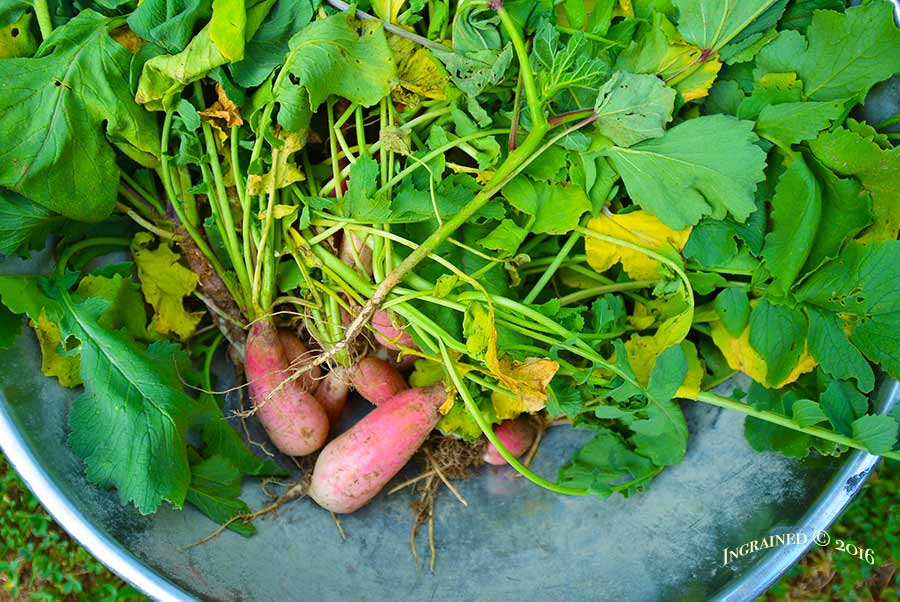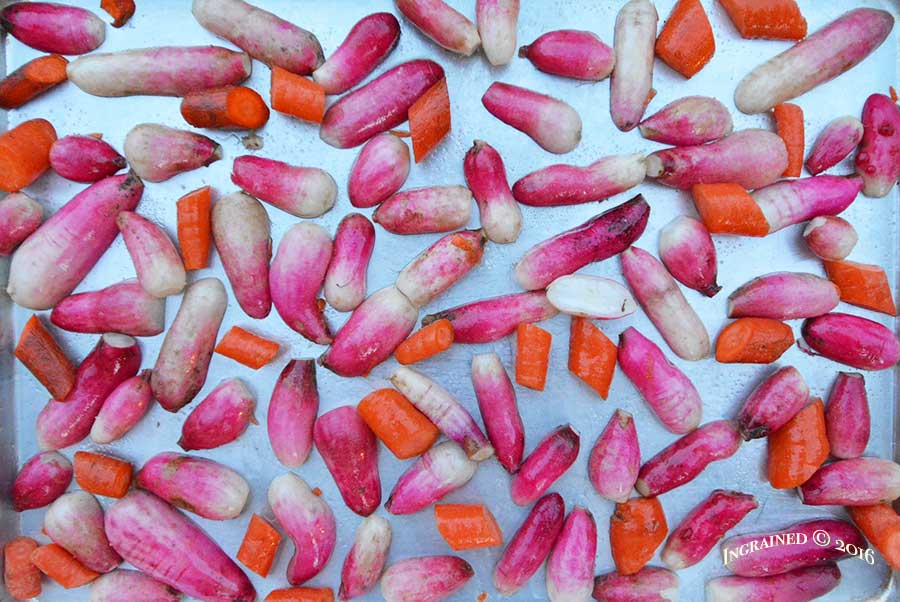
Our first harvest! My Farmer has been hard at work in our garden this year. Last year was our first year of fighting with the Tennessee clay to make a garden plot. The effort seemed futile, but we did manage to grow some cucumbers, squash, and purple hull peas. (Ever tried those? They are a favorite of mine from my childhood days visiting my grandparents in LA – Lower Alabama.)
A few bags of gypsum and organic matter, along with a good tilling by my Farmer left us with unbelievably transformed soil — rich, fine soil!
Radishes are our first harvest of the season, hopefully harbingers of the abundance to come! If you aren’t typically a fan of the peppery flavor of fresh radishes, try roasting them to bring out their natural sweetness. When once I would have avoided radishes at all costs, I actually planted these on purpose to roast them!
Radishes are root vegetables
Radishes are members of the cruciferous family of vegetables, cousins to cabbage, broccoli, brussels sprouts, kale, and turnips, among others. The typical part of the radish consumed is the root, a storage organ of nutrients for the plant. The leaves are actually also safe to eat and may be stir fried or braised much like any other green.
If you buy radishes with the greens attached, go ahead and cut off the greens and store them in the refrigerator separately from the roots. (You can place them in a vase of water as you would store cut flowers or you can wrap the roots in a damp paper towel and store them in a plastic bag.)
While we may overlook these blushing beauties in the produce section of the grocery store, they were actually so highly prized in ancient Greece that they were honored with golden replicas of themselves!

A Radish for Every Season
There are many varieties of radishes, some not so common in the United States as they are in Asia and other parts of the world. You may be most familiar with the Cherry Belle Radish, a small, round, vibrant magenta radish best suited for cool season growth. The particular variety of radishes that we planted are an organic heirloom variety called Fresh Breakfast Radishes from the company Botanical Interests. I am quite enamored by the lovely seed packets from Botanical Interests and would purchase their entire seed collection just for the artwork!
Did you know that there are radishes suitable for planting in different seasons? According to this information on “Growing the Best Radishes” from Botanical Interests, radishes are classified into spring, summer, and winter varieties. If the weather is too hot for the radish variety, or if there is an inadequate water supply, the plant will divert energy and nutrients away from root development and to the leaves and flowers instead.
I think we planted our particular variety of radishes a tad late in the season and the soil temperature was too hot, causing the radishes to become overly pungent and pithy. Radishes should optimally be harvested when they are a little smaller for the best flavor. If picked too late they may become pithy or bitter. (In other words, bigger isn’t always better!)
It isn’t too late to plant radishes this year! If you are planting in the summer, a white icicle variety will be more likely to withstand heat. You could also intersperse these among plants that will shield them from too much sun, such as corn. Daikon radishes are white winter radishes, suited to the cooler weather and shorter days of autumn.
For a more exotic winter radish, try the Radish Watermelon Mantanghong variety. A white exterior and red interior of this radish makes for a lovely presentation, and when sprinkled with black sesame seeds earns it the “Watermelon” part of its name. Sow both winter radish varieties 8-10 weeks before the first fall frost. I look forward to trying more varieties in our garden!

Roasted Root Vegetables
Isn’t this a beautiful summer spread? The pink and orange colors remind me of vibrant summer sunsets. I first tried roasting radishes when we received a bunch of them in our CSA (Community Supported Agriculture) box a few years ago.
Radishes were one of the vegetables that I had never liked, but, determined not to waste our costly produce, I did a quick search for radish recipes and found a few posts for roasted radishes. I prepared the entire bunch for my family, but before they came in from the field (confession) I had consumed the entire pan!
If you aren’t typically a fan of the peppery flavor of fresh radishes, try roasting them to bring out their natural sweetness. The addition of carrots and maple syrup also helps to tame the stronger flavor of radishes. (We are hoping for a carrot harvest later this year – their lacy tops are promising!)
I roast radishes in organic, expeller pressed coconut oil (I don’t like the taste of coconut with my radishes) and sprinkle with Himalayan pink sea salt. I don’t use pepper, but feel free to add to your liking.
(Don’t have both vegetables? This recipe will work just fine using either just carrots or radishes.) To really dress up these radishes, serve with a bit of browned butter, a spritz of lemon juice, and a sprinkle of chopped, fresh radish leaf or parsley.
- 1 pound Radishes, any variety
- 1 pound Carrots (either baby carrots or sections of whole carrots)
- Coconut oil (organic expeller presses) or other high heat oil
- Sea salt
- Freshly ground pepper (optional if you like this flavor)
- 1 Tablespoon Organic Dark Amber Maple Syrup (optional to diminish bitterness)
- Preheat oven to 400˚F. Adjust oven to middle rack.
- Trim leaves from radishes (and carrots if using whole, fresh carrots). Wash radish roots and carrots and pat dry. Cut into halves or quarters of uniform size (may leave baby carrots whole). The key is to ensure your vegetables are of even thickness.
- Add vegetables to baking sheet and toss with coconut oil. Sprinkle with sea salt and freshly ground pepper (if desired).
- Bake at 400˚F for 20-25 minutes or until vegetables are tender and easily pierced by a fork.
- *If adding maple syrup, remove pan from oven after 15 minutes of cooking time and drizzle maple syrup over vegetables. Stir to coat, then return to the oven for the remainder of the cooking time.
- Serve hot!
What about you? Have you ever tried roasting vegetables? Have you ever discovered a new vegetable that you thought you could never enjoy? I would love to hear your ideas… just comment below or drop me a line at Bethany@ingrainedliving.com.
Here’s to Wholesome! (and to garden fresh produce!)
~Bethany


